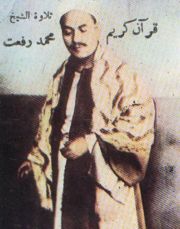Difference between revisions of "Qur'anic recitation (tilawa)"
| Line 1: | Line 1: | ||
| − | '''Qur'anic recitation''' (tilawa | + | '''Qur'anic recitation''' (tilawa, qira'a, tajwid, tartil) is regulated by three sources: |
* the mushaf (Qur'anic text) | * the mushaf (Qur'anic text) | ||
| Line 9: | Line 9: | ||
There are two primary styles of recitation: | There are two primary styles of recitation: | ||
| − | * Mujawwad: more florid, melodic, extended, fully exploiting the system of maqamat, including free improvisation, modulation, and cadential endings (qafalat); used in particular contexts (e.g. funerals, or before Friday prayer) and cultures (e.g. Egypt) | + | * Mujawwad (tajwid): more florid, melodic, extended, fully exploiting the system of maqamat, including free improvisation, modulation, and cadential endings (qafalat); used in particular contexts (e.g. funerals, or before Friday prayer) and cultures (e.g. Egypt) |
| − | * Murattal: more rapid, less melodic variation; used in different contexts (e.g. during prayer) and cultures (e.g. Saudi Arabia). Also uses maqamat, but in a more limited fashion; sometimes limited to a particular tetrachord. | + | * Murattal (tartil): more rapid, less melodic variation; used in different contexts (e.g. during prayer) and cultures (e.g. Saudi Arabia). Also uses maqamat, but in a more limited fashion; sometimes limited to a particular tetrachord. |
There are also stylistic variations between regions; though the Egyptian style has been dominant for several centuries, the Saudi style (and murattal generally) is increasingly heard, due to strength of Saudi media worldwide. Everywhere reciters deploy the Arab maqamat for recitation, even in non-Arab Muslim countries where Arab music is not heard (e.g. in Indonesia, Iran, or Pakistan). | There are also stylistic variations between regions; though the Egyptian style has been dominant for several centuries, the Saudi style (and murattal generally) is increasingly heard, due to strength of Saudi media worldwide. Everywhere reciters deploy the Arab maqamat for recitation, even in non-Arab Muslim countries where Arab music is not heard (e.g. in Indonesia, Iran, or Pakistan). | ||
Revision as of 21:44, 6 October 2010
Qur'anic recitation (tilawa, qira'a, tajwid, tartil) is regulated by three sources:
- the mushaf (Qur'anic text)
- the qira'at (which add diacritical markings to that text)
- ahkam al-tilawa (rules for recitation)
Applying these sources still allows plenty of room for variation, and thus multiple styles form.
There are two primary styles of recitation:
- Mujawwad (tajwid): more florid, melodic, extended, fully exploiting the system of maqamat, including free improvisation, modulation, and cadential endings (qafalat); used in particular contexts (e.g. funerals, or before Friday prayer) and cultures (e.g. Egypt)
- Murattal (tartil): more rapid, less melodic variation; used in different contexts (e.g. during prayer) and cultures (e.g. Saudi Arabia). Also uses maqamat, but in a more limited fashion; sometimes limited to a particular tetrachord.
There are also stylistic variations between regions; though the Egyptian style has been dominant for several centuries, the Saudi style (and murattal generally) is increasingly heard, due to strength of Saudi media worldwide. Everywhere reciters deploy the Arab maqamat for recitation, even in non-Arab Muslim countries where Arab music is not heard (e.g. in Indonesia, Iran, or Pakistan).
Listening
Listen to a variety of Egyptian and Saudi recitations of the same passage from Surat Yusuf. Shaykhs Muhammad Siddiq al-Minshawy and Shaykh Mustafa Ismail are Egyptians. Shaykh Muhammad Gabril is also an Egyptian, but who adopts the Saudi style to a great extent. Shaykhs Abu Bakr al-Shatiri, Ahmad al-Agami, Ali Abd al-Rahman al-Hudhayfi, Muhammad Ahmad Badr, Sa`d al-Ghamidi, and Su'ud al-Sharim are all Saudis.
Now listen to longer segments, focussing on differences between Egyptian, Saudi, and Turkish styles:
- Qur’anic recitation (mujawwad). Performed by Shaykh Muhammad Rif‘at (May 9, 1882 - May 9, 1950), the earliest great reciter to be recorded in Egypt, during the early part of this century. This is again the mujawwad style; note the pauses, repeats, slow delivery, melisma, melodic inventiveness. This style allows the performer to maximize emotional power, a technique not dissimilar to the tarab process deployed by the secular singer. The text comes from the beginning of Surat Yusuf (chapter narrating the story of the Prophet Joseph); follow along.
- Qur’anic recitation (mujawwad). Performed by Shaykh ‘Abd al-Basit ‘Abd al-Samad. A great Egyptian reciter who passed away relatively recently (1927-1988). Note how each reciter has his style. This too is mujawwad recitation; the text is again the beginning of Surat Yusuf. Here is a video example by the same reciter, from Surat Duha. Note copious listener response following completion of a phrase, as in tarab music.
- Qur’anic recitation (murattal). Performed by Shaykh Ahmad bin Ali ‘Ajami, from Saudi Arabia. Note the contrast with the previous two examples: here, recitation is rapid, narrower in melodic scope, little melisma, always moving forward without pauses. This style, called murattal, was traditionally used for study and private devotions. Recently it has become more popular for listening, probably due to Egyptian worker migration to Saudi Arabia, as well as increasing religious conservatism; the conservatives critics often condemn the older mujawwad style as “singing” the Qur’an. From a commercial recording. Video: Surat Qiyama, with imagery of Mecca. Video showing the Shaykh himself
- Competitions are common; here is the Iranian winner of a recent competition in Calcutta (India)
- More about Qur'anic recitation...

